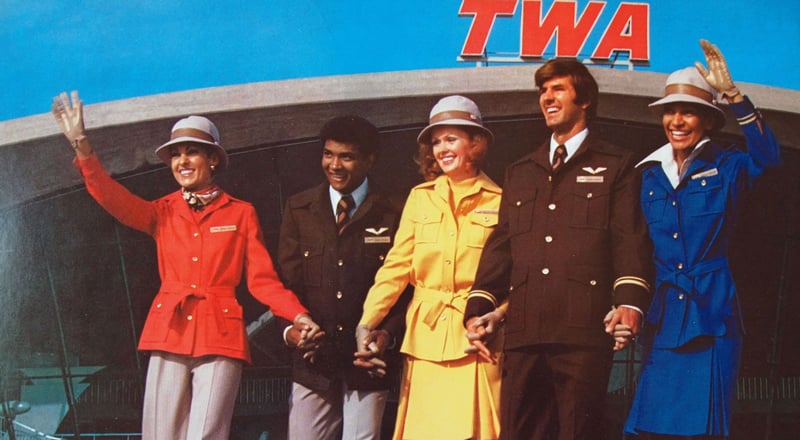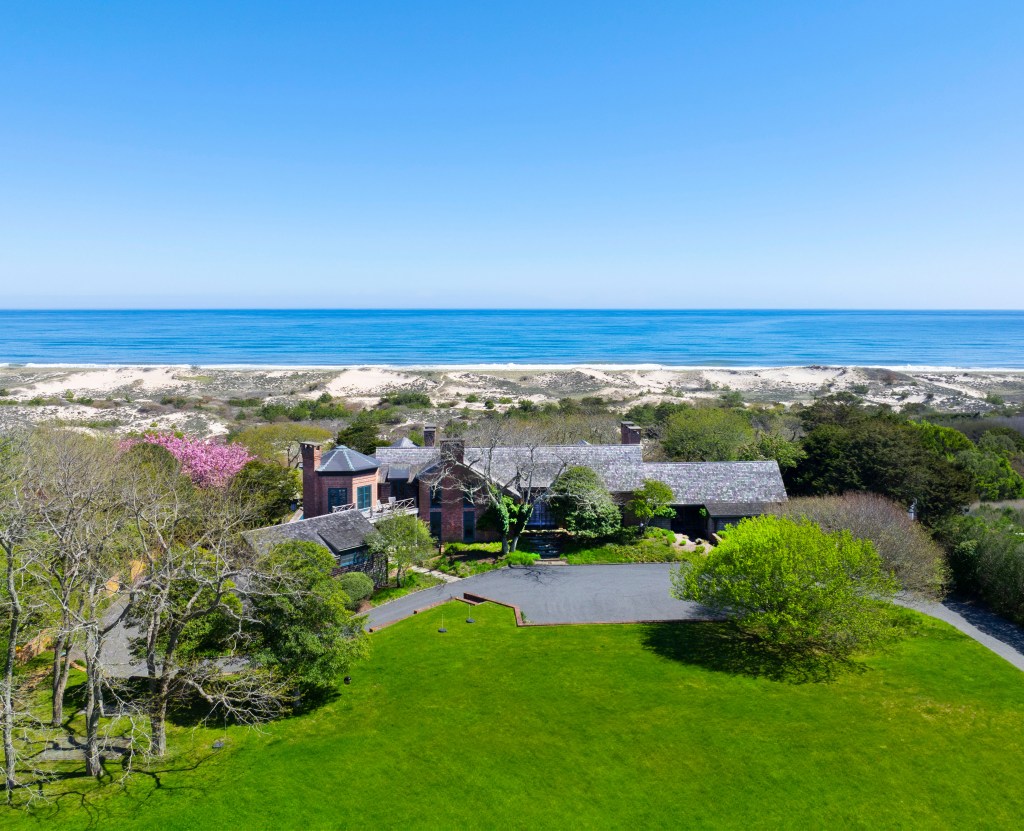Stan Herman: Uniform Fashion Designer for the Working Man

From the classic striped McDonald’s blouses of the 1970s to the sharp purple-black contrast of modern FedEx polos, some uniforms are designed to stand out, and for many of these iconic looks, we have Southampton fashion designer Stan Herman to thank.
From his early years helping out in his father’s silk shops, Herman knew wanted to pursue fashion design as his career, and his father supported him. “My father was very encouraging. It was quite unusual for a Jewish father to have a son who wanted to be a fashion designer,” says Herman, who has continued to work in fashion into his 90s.
His first corporate client in need of a uniform rebrand was Avis Car Rental, and he has since created looks for Amtrak, JetBlue, Loews Hotels & Resorts, Trans World Airlines, U.S. Airways, United Airlines, the Central Park Conservancy and most recently Sandals Resorts. He is also renowned for his women’s ready-to-wear designs and loungeware, and he’s currently celebrating 30 years on QVC.
Living in New York City in the 1950s, Herman and his partner Gene Horowitz, a writer and teacher, discovered Southampton in 1953 and were awestruck. “I came out here and looked at a lake called Big Fresh Pond and said, ‘That’s where I’m going to live the rest of my life,’ and that’s where I’ve lived the rest of my life,” Herman says. “I’m on the same piece of property that I rented back in 1953 with my lover of 40 years.”
For decades, Herman and Horowitz were a force for good in the Hamptons. In the advent of the AIDS crisis, they helped found the East End Gay Organization (EEGO), with Herman becoming one of the original chairs. Through the organization they built bridges between the gay and lesbian community and raised considerable funds for AIDS relief at events such as Take Off at the East Hampton Airport, which Herman chaired.
“The catalyst for everything was the AIDS epidemic. That brought people together like it never happened before — men and women — and the women were the first to respond out here,” Herman explains.
In 1991, Horowitz died suddenly of a stroke.
“Both Gene and I were poster children for the gay movement. We were very open,” Herman says of his “phenomenal love affair” with Horowitz. “Our relationship was never anything but open and accepting of our homosexuality in a world that wasn’t so accepting of it.”
That year, Herman was brought on as the president of the Council of Fashion Designers of America (CFDA). “I was out of left field … I was doing ready-to-wear for the mass market. It started, again, during the AIDS world when the CFDA did a massive ‘7th on Sale.’ In a three-day sale, we raised $5 million and raised the profile of the Council of Fashion Designers of America,” he explains. “They tapped me to be president of it, and I had the time and the desire for it. I thought it would be two, three or four years, and it ended up being 16 years. It was a fun, little position. My board at the time was Ralph Lauren, Donna Karan, Mary McFadden, Geoffrey Beene, Oscar de la Renta, Bill Blass — you’re talking the crème de la crème. I was a good president, because I wasn’t in that business and wasn’t competitive with them, so they became my friends and helped me build a very solid organization, which was really more of a peripheral honorary group, into a fundraising behemoth.”
Along with his right hand, CFDA Executive Director Fern Mallis, he is well-known for consolidating the citywide events known as “New York Fashion Week” into an organized grouping of tented events in Bryant Park. This reenvisioning of events was branded as “7th on Sixth” and sold to IMG in 2001.
In 2006, Herman passed the baton. “When I was about ready to go, we selected Diane von Fürstenberg, and she brought it to another international level,” he says. “But I’m still on the board and am very much involved in it.”
Additionally, Herman is involved with the Bryant Park Corporation, the Garment District Alliance, and he even served on the Midtown Manhattan Community Board for 25 years, acting as the head of new construction.

What else can you share about your life in the Hamptons?
My roots in the Hamptons are very deep, very rich. I’m still in New York, I’m still working. I go back and forth, but this is really what my home seems to be at this point. …
EEGO was a coming together of men and women, which was very unusual at the time, because most groups were either men or women. … It was an extraordinary group of people. … One of the people who was very much involved with EEGO was Edie Windsor. Edie was one of my closest friends; we started together and she was part of the EEGO world.
EEGO split up because the Hamptons is a weird gay area. When I first came out here, there were a few gay bars. There was one up in the hills of Bridgehampton right near what used to be a racetrack. It was the gay bar out here. We only had one, and then suddenly it spawned The Attic and a number of other gay bars.
It was not a comfortable place for Southampton gays. They were much too behind the hedges and decided that — I’m sort of making a generality here — they’d rather have their own party. Like a lot of places, we don’t have a gay bar to this day. The gays are behind the hedges; they’ve built them higher and higher and more exclusive and moved away from the revolutionary moment we had. …
The beaches were open to us. Those of us who weren’t Fire Islanders loved that. And EEGO was a wonderful thing in our lives. I met people I would never have known. To have been here as long as I have and been so involved with the city and with the town, what it looked like when I first came here and what it looks like now, it’s really quite fascinating.

What do you feel is unique about your approach to designing uniforms?
I think it’s the way I design clothing in general. In my life right now, I do loungewear for women at home and uniforms for people who work. I do real clothes. I’ve always done real clothes, and uniforms are the most realistic of them all. When I first started to do it, people were wearing posterboards for the company. When I was first hired by TWA, I said to them, “I want the uniform to look like clothing that these people would have bought themselves.” And that seemed to have worked. The same thing as when I was a very hot designer doing ready-to-wear — they were just clothes for people who wanted to look sharp and comfortable. … I learned how to bite off the edges of fashion — not compete but do my own thing. …
I don’t search out these accounts, they seem to come to me. If I wanted to, I’d probably have a much larger business. I have a great associate who does most of the work now, and I sit here and say, “Yes. No. I like it. I don’t.” It’s a very comforting thing to see people wear your clothes when you do uniforms. When I walk through Central Park and I see my clothes on everybody, I feel very comfortable. I like the feeling. For 20 years, I was the designer for McDonald’s, and I did all of their seminal uniforms that are in the Smithsonian. That’s a nice badge of honor.
What has been the most rewarding aspect of your fashion career?
I think the most rewarding thing is probably my longevity. … And as an aged person now, who’s really in the last legs of his life, I’m so content. I like the life I’ve lived. I had a great love affair. I’ve loved working. I came to a part of the world out here that is just extraordinary, and I think the waters from the canals and from the ocean have kept me fresh and young. I wish my lover had lived longer, but other than that I wouldn’t change anything. I’m a happy camper.
Stan Herman’s upcoming memoir Uncross Your Legs is expected to release in summer 2023.



